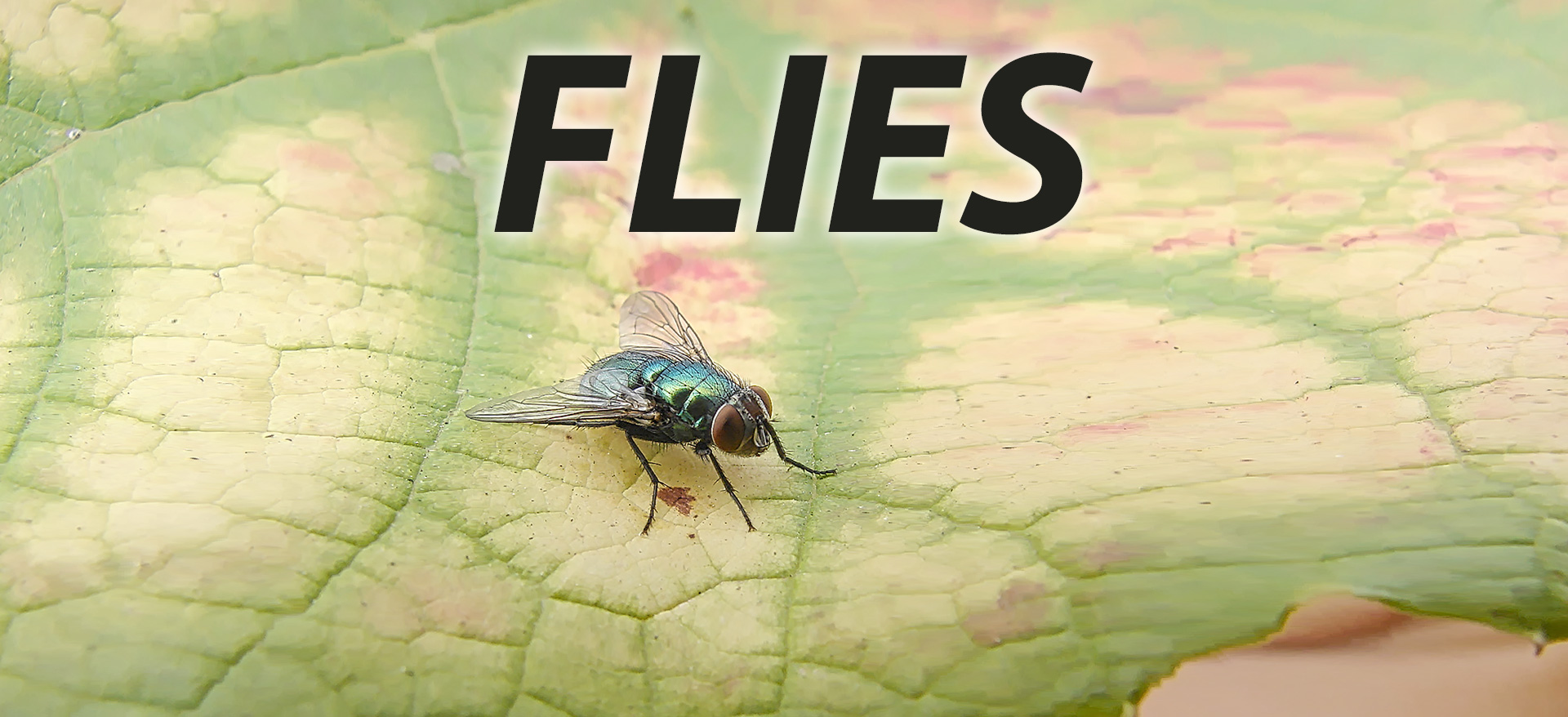29 Aug Flies
Background Information
There are many different species of fly that may cause problems in your property. Common pest species include fruit flies, sewer flies and house flies. Fruit flies are usually found near rotting food sources. Sewer flies feed on organic material that builds up in drains; their presence can indicate a break in the sewer system or a leak. Houseflies are usually found near their food sources, often rotting food and/or manure; they may be active indoors throughout the year, especially in warm houses.
Please see the page below for information on each species of common pest fly.
How did the Fly problem occur
Most types of pest fly are attracted to your property as there are favourable conditions for them to breed there, whether this is rotting fruit or food waste, a dead animal carcass (eg rat) or a leak in a pipe. High standards of cleanliness and housekeeping are often enough to keep flies at bay. The breeding ground is the larval food source; eggs are usually laid directly onto the food source.
Please note. it is imperative that you take our advice in finding and removing the breeding ground of the flies for successful control. Our insecticide treatments are a short term method of control designed to kill any flying adults at the time; they cannot prevent the flies from breeding further.
What Will Happen During The Visit
Correct identification of the fly species is required to know where to look for the breeding source. If the technician cannot identify the species they will take a sample for our biologist to identify in the office.
The infested area will then require treatment with insecticides. This involves spraying one chemical to the infested areas, which contains a fast-acting insecticide and a growth regulating hormone to quickly reduce the infestation. The technician will then fog the affected area using an ultra-low volume insecticide. Depending on the type of fly, the technician may also place fly traps that can attract some flies (eg fruit flies) with a sugar bait.
Residual Insecticides
Infested areas are sprayed with an insecticide solution that dries onto the surface. The insecticides we use are not hazardous to people or pets once they have dried. Please arrange to be out of the property for 3 hours following treatment.
These insecticides remain active for two weeks following the spray. Please refrain from mopping or vacuuming treated surfaces during this time, as it will reduce the effectiveness of the treatment.
Other Control Methods
There are also other various methods of control available, including:
- Electronic Fly Killers (EFKs) – used mainly in restaurants or food preparation premises, a UV (ultra violet) light attracts the flies, which are then electrocuted.
-
Fly screens – these can be used to prevent flies entering your building through open doors or windows. These are particularly useful for mosquitoes and other biting flies.
Help Prevent Re-Infestation
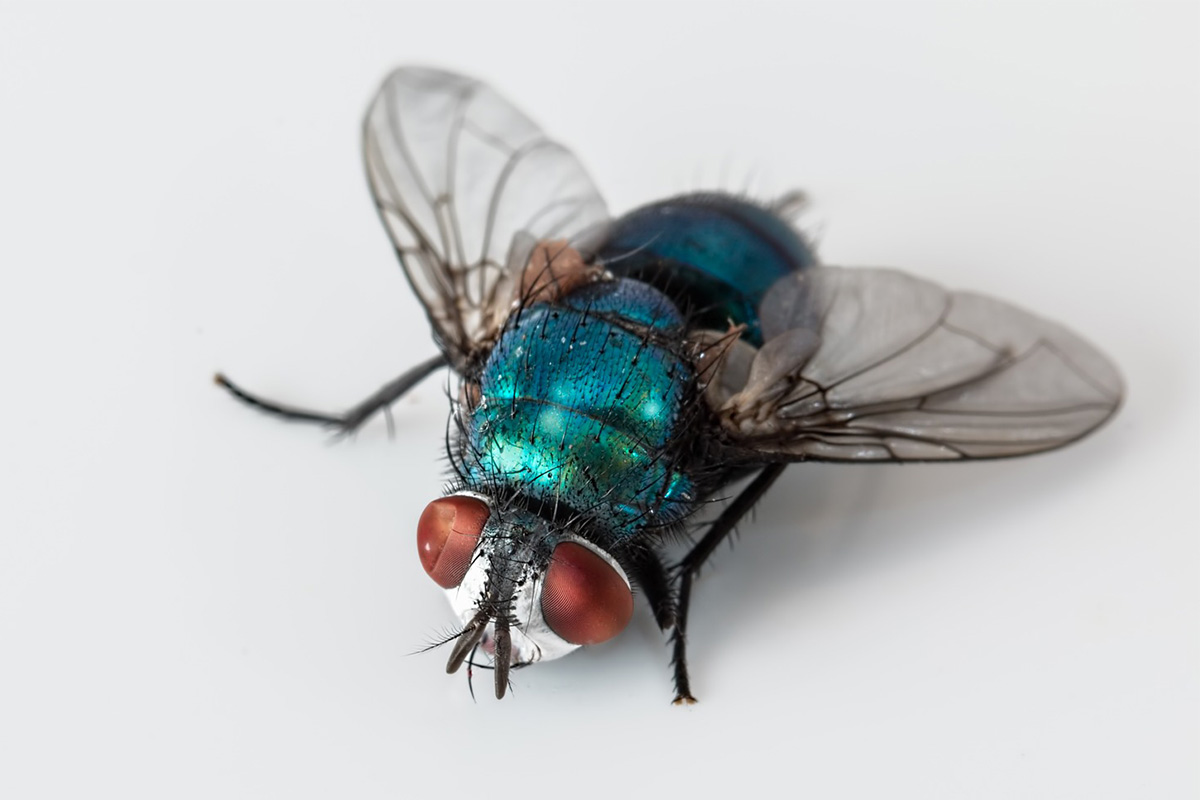
The best long-term prevention involves adhering to a high standard of housekeeping & cleanliness. This includes:
- Careful inspection of foodstuffs
- Close attention to food hygiene measures
- Regular cleaning
- Prompt garbage disposal,
- Good kitchen maintenance and organised food storage
Commonly encountered types of pest fly
Correct identification of the type of fly is required for control to be successful. In most cases we will identify the fly down to the family, as this is sufficient to know what further efforts will be required to find and remove the breeding source. Below are the most common types of fly that we are asked to deal with:
Common House Fly (Musca domestica)
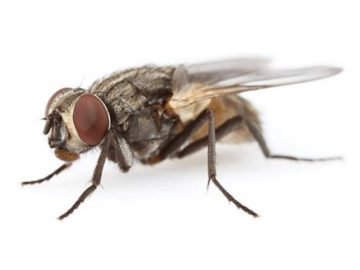
- Appearance: 6-8mm long, large red eyes, greyish with pale stripes on thorax.
- Life cycle: 2-10 weeks depending on conditions.
- Behaviour, diet & habits: Breed in rotting vegetable matter or animal faeces. Cause major issues in animal housing and at rubbish tips.
- Facts: Can spread diseases such as Salmonella & E.coli. Adults can travel up to 5km. EFK’s are less effective against houseflies
- Control: Remove larval food medium/breeding ground – good housekeeping and waste removal techniques are needed. If there is no obvious breeding source on site but there are large numbers of fly then other options such as fly screen for windows should be considered.
Blowflies: Blue Bottle & Green Bottle flies (Calliphoridae)
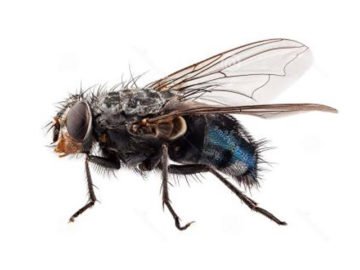
- Appearance: Large, noisy family of flies. 6-14mm long, coloured blue or green metallic abdomen (can be dull).
- Life cycle: Develop to maturity on average in 2 weeks (depends on conditions)
- Behaviour, diet & habits: Feed primarily on dead and decaying animal matter, preferably carcasses or meat offal. Their sudden presence in large numbers usually signifies fresh hatching from a nearby dead carcass of a wild animal/bird or poor management of waste meat/fish. In domestic situations this is often a dead rodent or bird.
- Facts: Can form significant problems in meat processing plants and commercial kitchens. Blue Bottles are more associated with humans than Green Bottles; Green Bottles are seldom attracted indoors.
- Control: In domestic situations the removal of the animal carcass combined with an insecticidal treatment to knock down the adults will solve the problem. Unfortunately, the animal carcass is often inaccessible. The adult flies are short lived (less than 3 weeks) so the issue will resolve itself once the carcass decomposes.
Fruit Flies (Drosophilidae)
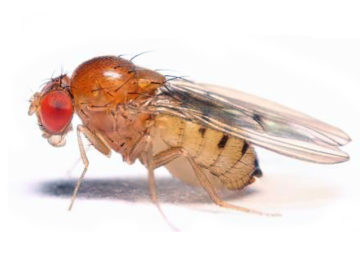
- Appearance: Family of 50 species. Small flies, generally 2-4mm. Colour can vary from light yellow to brown.
- Life cycle: 7 days in favourable conditions (30˚C) Larvae can survive at low temperatures at extended periods.
- Behaviour, diet & habits: Common names are usually derived from where they are found eg fruit fly, vinegar fly, beer fly. Usually breed on rotting vegetable/fruit, sour milk, beer & vinegar.
- Facts: Can cause major issues in commercial kitchens. They do have the potential to spread diseases. Due to their very small body size insecticide treatments can have limited effectiveness.
- Control: As insecticides are less effective against fruit flies, it is imperative that the breeding ground is found, removed and cleaned. This can be any type of organic material as mentioned above; more often than not it is over ripe fruit/vegetables in the kitchen. In an office environment tenants should check their desks/drawers for the source as well as checking the kitchen. If the source isn’t immediately obvious then check behind fridges/under kickboards for a build -up of organic material.
Scuttle Flies (Phoridae)
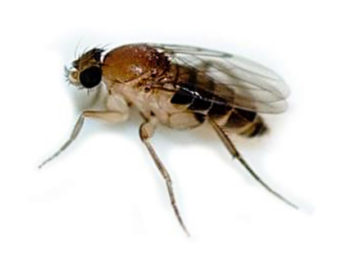
- Appearance: Can be mistaken for fruit flies. 3-4mm, pale brown to black in colour. Often have a humped appearance.
- Life cycle: Develop to maturity on average in 2 weeks, can take up to 42 days
- Behaviour, diet & habits: This type of fly is attracted to any wet, damp or decaying matter, such as foul water, sewage, also rotting food. They prefer to run rather than fly, hence their common name of scuttle fly. If they are forced to take to the wing they often land soon afterwards.
- Control: Removal of the breeding ground is vital. This can be a blocked or broken drain, leaky pipes (in bathrooms etc), or rotting food source. Unfortunately the problem is likely to persist even with insecticide treatment if the source isn’t located and removed. This may require you to contact a drain specialist for help locating the source.
Scuttle Flies (Phoridae)

- Appearance: Can be mistaken for fruit flies. 3-4mm, pale brown to black in colour. Often have a humped appearance.
- Life cycle: Develop to maturity on average in 2 weeks, can take up to 42 days
- Behaviour, diet & habits: This type of fly is attracted to any wet, damp or decaying matter, such as foul water, sewage, also rotting food. They prefer to run rather than fly, hence their common name of scuttle fly. If they are forced to take to the wing they often land soon afterwards.
- Control: Removal of the breeding ground is vital. This can be a blocked or broken drain, leaky pipes (in bathrooms etc), or rotting food source. Unfortunately the problem is likely to persist even with insecticide treatment if the source isn’t located and removed. This may require you to contact a drain specialist for help locating the source.
Sewer / Drain Flies (Psychoda species)
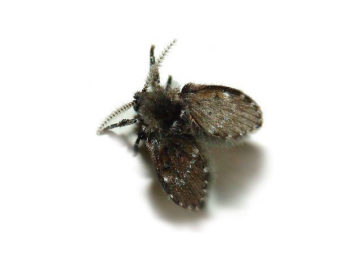
- Appearance: Tiny flies up to 2mm long. Distinctive ‘moth’ shape; hairy wings look too big for the body
- Life cycle: Develop to maturity in 10-50 days depending on conditions.
- Behaviour, diet & habits: As with scuttle flies, this type of fly is attracted to any wet, damp or decaying matter. The larvae feed on decaying matter, particularly in drains where organic sludge has accumulated over time.
- Control: Removal of the breeding ground is vital. This can be a blocked or broken drain, leaky pipes (in bathrooms etc). Often a thorough clean of the drainage system will remove the organic sludge that has built up. Unfortunately the problem is likely to persist even with insecticide treatment if the source isn’t located and removed. This may require you to contact a drain specialist for help locating the source.
Fungus Gnat (Sciaridae species)
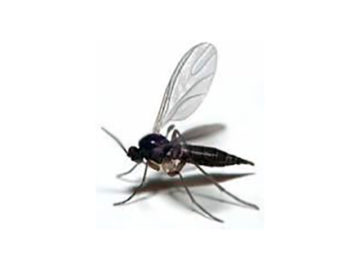
- Appearance: 4mm, black with a distinctive pointed abdomen.
- Life cycle: Develop to maturity in 4 weeks on average.
- Behaviour, diet & habits: In domestic environments and offices they are usually associated with stagnant water in plant pots and displays. This can happen when the plants are overwatered. The larvae feed on any decomposing organic plant material. They are air-born most of their adult life, they fly slowly and are often attracted to people exhaling breath.
- Facts: There are around 1700 species worldwide, with many more thought to be awaiting discovery in the tropics. Females do not need males in order to breed.
- Control: In an external area or greenhouse they can be very difficult to control. In an office or domestic environment control is usually achieved by removing the plants where they are breeding (sometimes just not watering the plants as much can result in control). If there are no plants in the vicinity then they can also be associated with bath and sink overflow and stagnant water that may have resulted from leaks. This should be checked by a specialist. An insecticide treatment can help with quick knockdown of the adults; this is particularly useful when the flies are bothering tenants in an office environment. This will only bring temporary relief though; the source needs to be removed too.

